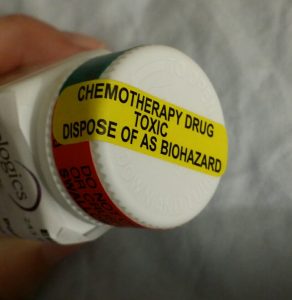It’s been ages since I posted, but that’s because there’s been nothing new to report.
I recently began treatment with one of the new-ish monoclonal antibodies called Darzalex (daratumumab, aka dara). In addition to Darzalex, I’m taking an older drug that I’ve used before, called Revlimid. Once a week, I take a 20mg dose of dexamethasone.
It had been a little more than 9 years since I had any treatment for myeloma. After a stem cell transplant in 2007, I had no need for treatment. My disease stayed pretty stable for several years. Then, about 3 years ago, I began to relapse a little more noticeably. Finally, my doctor thought it was necessary to start treatment before I started to exhibit any symptoms. Only recently, my RBCs dipped below normal.
 I’ve had two infusions of dara so far. the first one took several hours to complete because of an infusion reaction. My blood pressure shot up to 203/97 and I developed a wheeze. The treatment was stopped for a while, and then the infusion was resumed at a lower rate. I was at the clinic for almost 12 hours that day. I’ll write more about that in a future post.
I’ve had two infusions of dara so far. the first one took several hours to complete because of an infusion reaction. My blood pressure shot up to 203/97 and I developed a wheeze. The treatment was stopped for a while, and then the infusion was resumed at a lower rate. I was at the clinic for almost 12 hours that day. I’ll write more about that in a future post.
As for Revlimid, I had that in 2006. It did very little for me, but I’m on it because my insurance company won’t pay for Pomalyst. This is because the dara/pom combination is considered “off-label” use. The price tag for Rev is about $11k per month, and Pom is about $13k per month. My clinic has billed about $45k for each infusion of dara. It’s hard to imagine, really!
Another first for me is that I’ve had a port implanted to handle the frequent infusions. It was an outpatient procedure. I was in at 7:15 Friday morning and out by 10:30 am. There’s some discomfort, but it’s not terrible. The surgeon prescribed some norco tablets. He even gave me a prescription for a lidocaine gel to apply before port accesses to numb the area before the needle is inserted.
That’s it for me now. I’ll provide some more details in future posts.